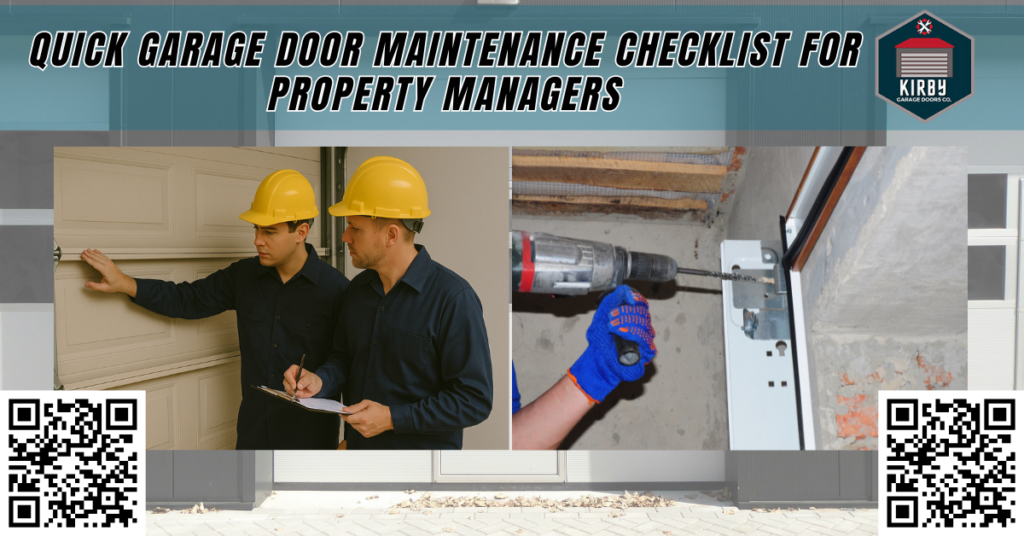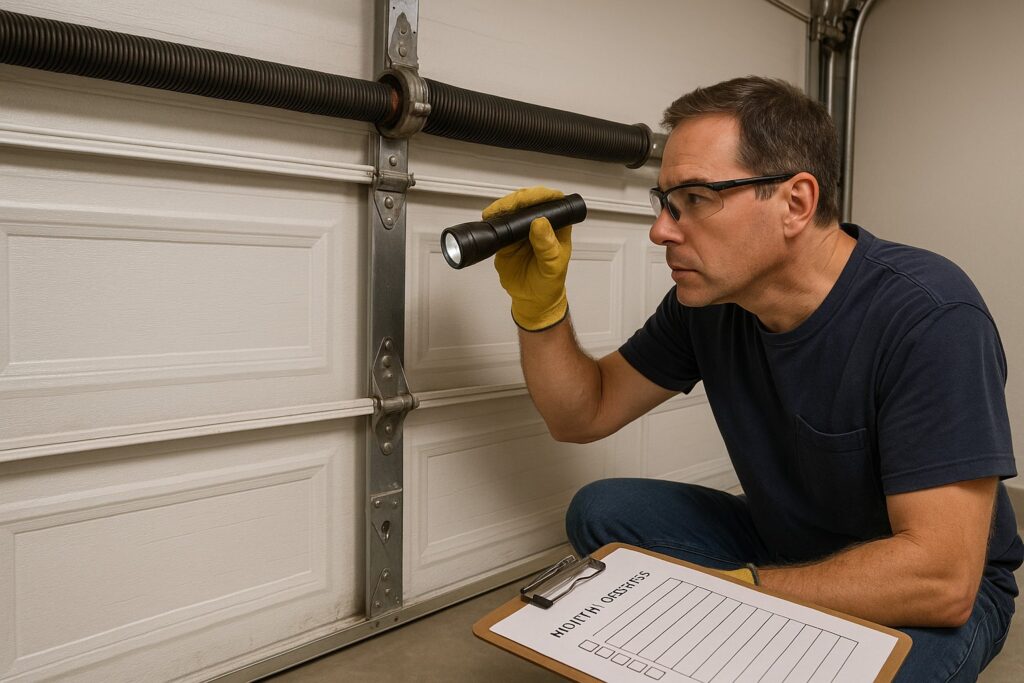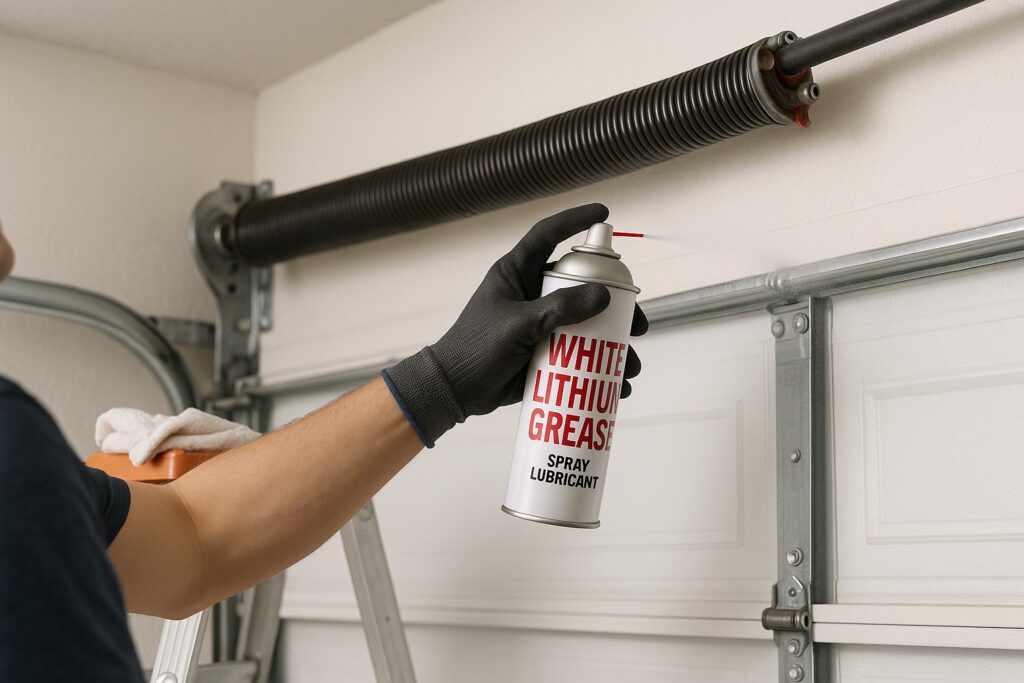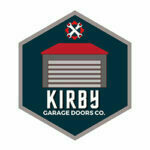Quick Garage Door Maintenance Checklist for Property Managers

In Houston’s unpredictable climate, property managers can’t afford to overlook garage door maintenance. One property manager we assisted had 40 townhomes, each with a garage door showing signs of neglect. Rust spots, squeaky rollers, misaligned tracks, and sluggish openers were common complaints. After we completed a preventative maintenance overhaul, tenant satisfaction improved, service requests dropped by 30%, and the lifespan of each door system was extended significantly.
According to the National Association of Residential Property Managers, garage door-related issues are among the top five maintenance calls. These issues are preventable. Garage doors are one of the largest, most frequently used moving parts of any building. From worn-out torsion springs to misaligned garage door tracks, staying proactive can save both time and money while ensuring the safety of your residents and the reliability of your property’s infrastructure.
This comprehensive guide by Kirby Garage Doors Co. will equip property managers with the knowledge needed to perform regular garage door maintenance. Whether it’s a wood door affected by water damage or a steel system struggling with rust and debris, our step-by-step guide will help ensure every door on your property functions with quiet, smooth operation year-round. This guide also provides insight into the features of modern garage door systems, recommended maintenance intervals, safety tips, and the importance of using the right products, such as spray lubricant and white lithium grease.
Why Garage Door Maintenance Is Crucial for Property Managers
Garage doors aren’t just access points; they’re critical security features that affect safety, insulation, curb appeal, and tenant convenience. A stuck or malfunctioning garage door opener can delay a family’s commute, damage property, or even cause injuries. Poorly maintained garage doors also reduce the overall aesthetics of your property, sending the wrong message to potential renters or buyers.
Neglecting garage door parts like hinges, springs, cables, and rollers leads to increased wear and tear. Garage door springs, in particular, carry tremendous tension and, if broken, can disable the door entirely or become a safety hazard. Additionally, modern garage door openers come with built-in safety features like the auto-reverse function and motion sensors, which must be regularly tested to ensure optimal operation.
For property managers responsible for overseeing multiple garage doors, maintenance must become a consistent and organized process. A proactive approach minimizes emergency calls, reduces repair costs, prevents damage from weather exposure, and helps protect the value of the property. Creating a documented preventative maintenance program will also demonstrate your commitment to safety and property care, which can increase tenant retention.
How Often Should You Perform Garage Door Maintenance?
Garage doors should receive basic inspections monthly, with more detailed maintenance every six months. High-traffic commercial properties or multi-family complexes may require even more frequent servicing depending on use cycles, environmental exposure, and the age of the system.
Establishing a maintenance schedule is essential:
- Monthly: Conduct visual inspections, test sensors, and clean the surrounding area.
- Quarterly: Lubricate all moving metal parts, inspect for unusual wear, and test manual operations.
- Biannually: Schedule professional inspections, balance testing, cable tension adjustments, and spring calibration.
- Annually: Review the entire system for parts replacement, energy efficiency upgrades, and structural assessments.
Use a checklist or digital property management tool to log each maintenance session and track recurring issues or service notes for each door system.
1. Visual Inspection Checklist
The first step in any maintenance routine is a detailed visual inspection of every garage door system on the property. This task can often be completed quickly and should be part of your monthly checklist.

Inspect Garage Door Panels and Surfaces
- Look for dents, rust spots, peeling paint, and water damage on both metal and wood doors.
- Check for gaps, cracks, or separation in weatherstripping or insulation panels.
- Confirm that panels are flush and properly aligned; misalignment can be a sign of structural stress.
Examine Garage Door Tracks and Rollers
- Inspect both vertical and horizontal garage door tracks for dust, debris, or obstructions such as leaves or spider webs.
- Rollers should rotate smoothly with no grinding or wobbling. Any flat-sided, chipped, or seized rollers should be replaced immediately.
Check Torsion Springs, Cables, and Hinges
- Torsion springs must be free of rust and evenly coiled with no visible gaps.
- Check that lift cables are tight, without visible fraying, and securely fastened to the drum and bottom bracket.
- Use a socket wrench to tighten all nuts, bolts, and roller brackets that may have loosened due to vibration.
This inspection should be completed multiple times per year to stay ahead of serious issues.
2. Test the Door Balance
An unbalanced door puts stress on the garage door opener, can reduce energy efficiency, and increases the risk of property or vehicle damage. It can also cause uneven wear on tracks, cables, and springs.
Step-by-Step Guide to Test Balance
- Disconnect the automatic opener using the release handle or emergency cord.
- Manually lift the door about halfway and carefully observe the movement.
- A balanced door should stay in place without drifting.
- If it rises quickly or drops, the torsion or extension springs may need recalibration.
Be sure to check both single and double-car garage doors. Always call a professional if the balance is off, as spring adjustment is a high-risk task.
3. Lubrication: The Right Way
Keeping moving parts properly lubricated is crucial for quiet operation and reducing strain on the opener system. Always use the right lubricant for the task.
Where and How to Apply Lubrication
- Apply white lithium grease or silicone-based spray lubricant to:
- Steel rollers and shafts (avoid nylon wheels)
- Pivoting hinges
- Springs, bearings, and pulleys
- Arm bar connections and top rail contact points
Additional Lubrication Tips
- Avoid applying grease to garage door tracks; clean them with a dry cloth instead.
- Re-lubricate parts every three months, especially in high-use or dusty environments.
- Use a spray lubricant with a narrow straw to reach small areas without making a mess.
Using improper products, like all-purpose grease or household oils, can attract dirt and interfere with garage door performance.
4. Automatic Opener System Inspection
The garage door opener is a motorized system that controls door movement. It consists of the drive unit (chain, belt, or screw), sensors, logic board, and remote control systems.
What to Inspect:
- Auto-reverse feature: Place a block under the door. If it doesn’t reverse on contact, recalibrate or replace.
- Photo-eye sensors: Wipe lenses clean and ensure beams are aligned.
- Drive chain/belt: Inspect for sagging or slack. Lubricate lightly if needed.
- Remote control and keypad: Replace batteries and reprogram codes as necessary.
Consider upgrading older openers to newer models with built-in Wi-Fi, battery backup, and advanced safety features like motion detection and smartphone control.
5. Check Weather Seals and Insulation
Maintaining seals and insulation around garage doors improves energy efficiency and prevents moisture, pests, and cold air from entering garages or storage areas.
Inspection Steps:
- Press against the bottom seal to feel for soft spots or cracks.
- Visually inspect side and top seals for signs of pulling away, tears, or drying.
- Check for air leaks around insulated panel seams.
Replacing weatherstripping and bottom seals is a cost-effective way to extend door life and improve tenant comfort, especially during Houston’s hot summers and stormy winters.
6. Clean and Clear the Area
Cleaning supports safe and smooth operation and should be part of your monthly or quarterly routine.
Cleaning Checklist:
- Sweep or vacuum tracks to remove dust, grit, or rodent droppings.
- Wash exterior panels with mild detergent and water to remove grime or mildew.
- Inspect and clean areas around photo-eyes, bearings, and cable drums.
- Remove debris buildup from arm bars, hinges, and behind roller brackets.
- Apply anti-rust sealant to exposed steel areas.
Regular cleaning also makes visual inspection easier and more effective by eliminating obstructions.
7. Schedule Preventive Maintenance with Professionals
While some maintenance can be DIY, a professional technician should inspect all garage doors at least twice a year.
Services Offered by Kirby Garage Doors Co:
- Comprehensive 30-point inspection
- Spring tension and cable integrity checks
- Opener diagnostics and upgrades
- Professional-grade lubrication and calibration
- Rust prevention treatments

Professional service ensures compliance with safety standards and extends your equipment’s usable life by several years.
Maintenance Tips by Property Type
For Apartments and Townhomes:
- Maintain individual service logs for each unit
- Post signage about proper use and maintenance reminders
- Schedule rotating inspections to minimize tenant disruption
For Commercial Properties:
- Use industrial-grade doors and torsion springs
- Ensure overhead doors meet commercial safety codes
- Upgrade to smart garage systems with access monitoring
For Single-Family Homes:
- Provide welcome kits with basic garage door maintenance tips
- Encourage tenants to report unusual noises or delays
- Offer annual service plans to reduce tenant complaints
Don’t Ignore These Warning Signs
Some garage door problems require urgent professional attention:
- Banging or grinding noises during operation
- Door stops part-way through opening or closing
- Panel sagging or misalignment
- Cable fraying or detachment from drum
- Unresponsive or inconsistent door opener
- Failure of safety sensors to detect obstructions
Ignoring these signs could lead to costly repairs or serious injury. Act quickly.
Seasonal Garage Door Maintenance Guide
Different weather conditions impact garage door systems differently.
Spring:
- Remove salt or chemical residue from winter
- Lubricate all moving metal parts
- Inspect for rust or mold growth
Summer:
- Monitor door expansion due to heat
- Recheck opener motor and electronics
- Clean sensors exposed to more dust
Fall:
- Inspect for wind damage and replace seals
- Test opener battery backups
- Clean and repaint exterior doors if needed
Winter:
- Watch for freezing rollers and stiff tracks
- Lubricate regularly to prevent mechanical seizing
- Verify tight seals to block cold air and snow
Keep a Garage Door Maintenance Log
Tracking maintenance activities is essential for property managers.
Benefits of a Maintenance Log:
- Identify recurring issues by location or door model
- Maintain insurance and warranty compliance
- Support tenant dispute resolution with documentation
- Facilitate budgeting for repairs and upgrades
Use cloud-based tools or spreadsheets to organize information by property, date, and service type.
Final Thoughts
Garage door maintenance goes beyond cleaning and greasing parts. It involves systematic inspections, understanding mechanical systems, and taking preventative steps to protect your property’s functionality, appearance, and safety. From torsion springs and tracks to sensors and seals, every component plays a role in the overall performance of the garage door system.
By incorporating a consistent maintenance routine, using the right products like white lithium grease and spray lubricants, and partnering with experts for inspections and repairs, property managers can save time, reduce repair costs, and improve tenant satisfaction.
Take pride in the small details that lead to smooth operation, quiet doors, and secure homes and businesses. Kirby Garage Doors Co. is here to support you every step of the way.
How Can Kirby Garage Doors Co. Help You?
Based in Houston, TX, Kirby Garage Doors Co. specializes in reliable, expert-level garage door services for residential and commercial properties.
We provide:
- Quarterly and biannual preventative maintenance plans
- Same-day emergency garage door repairs
- New garage door and opener installations
- Smart garage upgrades and sensor calibration
Our team is equipped with the latest tools and training to handle a wide range of garage door systems and opener models. From garage door springs and rollers to logic boards and power cables, we deliver professional results with every visit.
📍 Visit Us: 7747 Kirby Dr, Houston, TX 77030
📞 Call Now: (281) 688-2203
📈 Serving: Houston, TX, and nearby Northeast areas
Let us handle your garage door worries so you can focus on managing your property. Schedule your custom maintenance plan today!
Frequently Asked Questions (FAQs)
1. What is the average lifespan of a garage door system?
Most garage door systems last 15 to 30 years, depending on usage, climate, and how well they’re maintained.
2. Can I use WD-40 to lubricate my garage door?
No, WD-40 is a cleaner, not a lubricant—use white lithium grease or silicone-based spray lubricant for best results.
3. How do I know if my garage door opener needs to be replaced?
If your opener is over 10–15 years old, lacks safety features like auto-reverse, or makes loud noises, it may be time for an upgrade.
4. Are smart garage door openers worth the investment?
Yes, smart openers offer added security, remote access, and real-time alerts—especially helpful for managing multiple properties.
